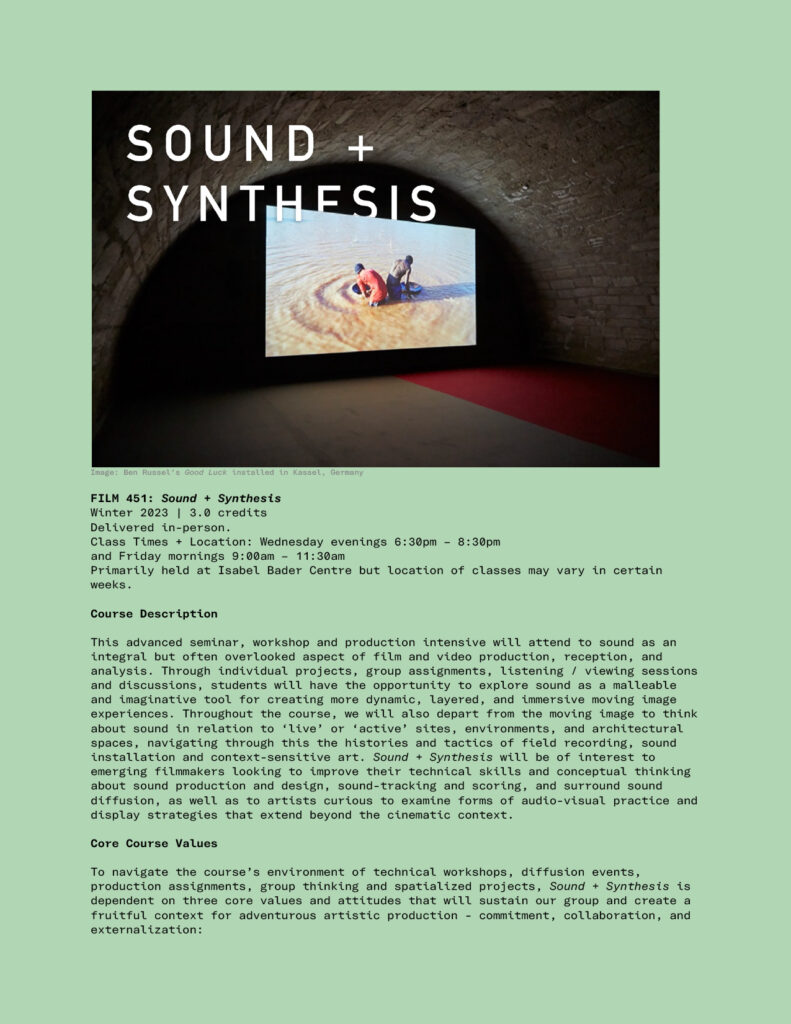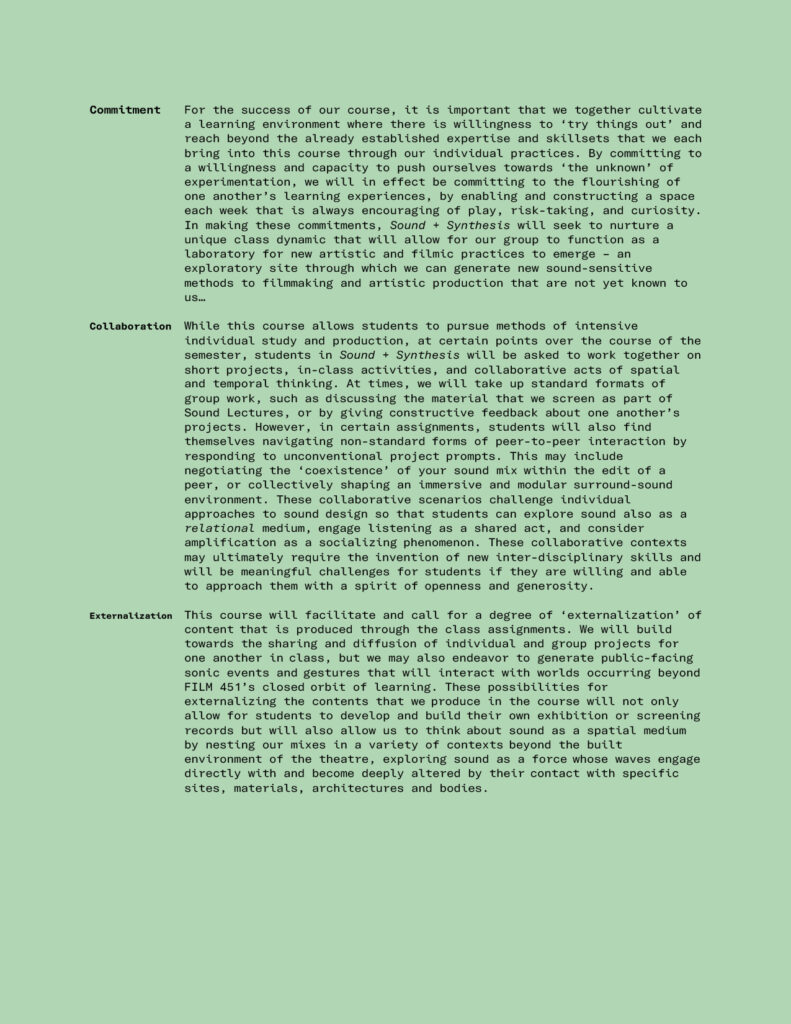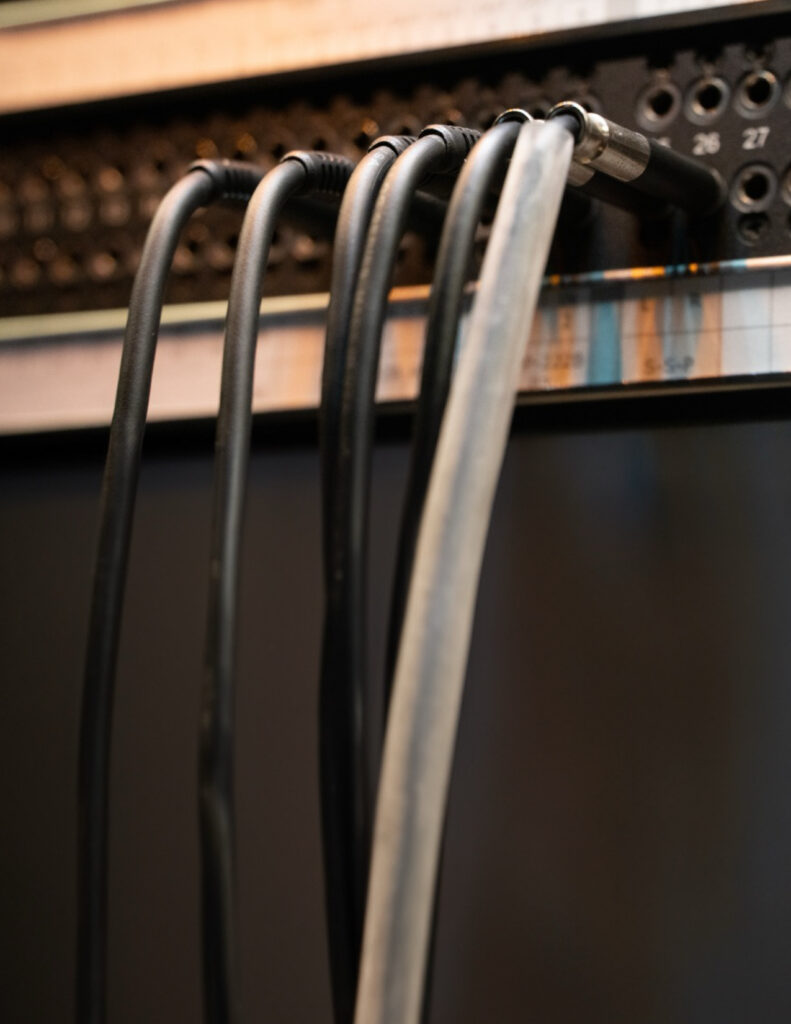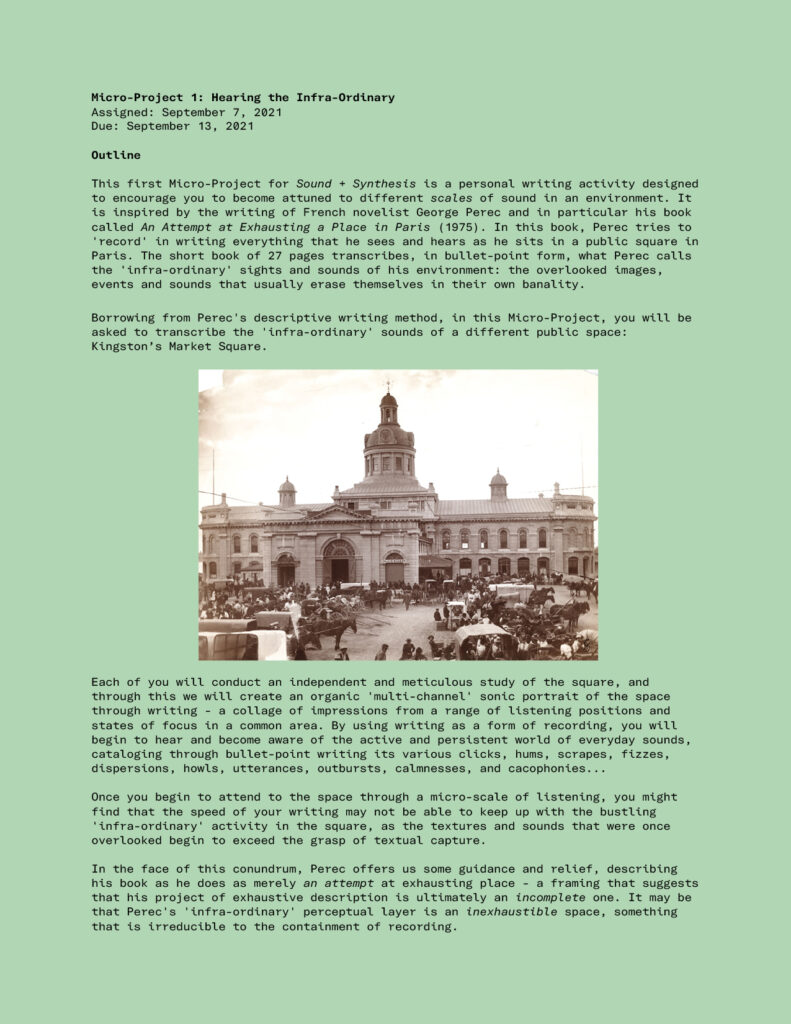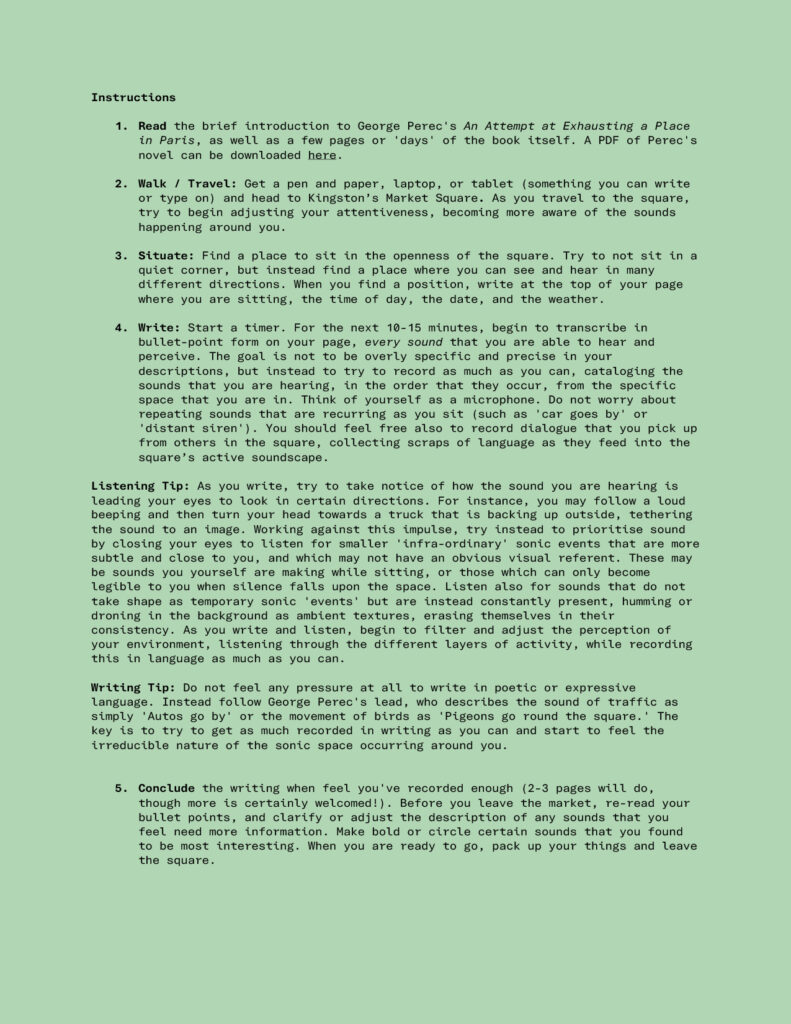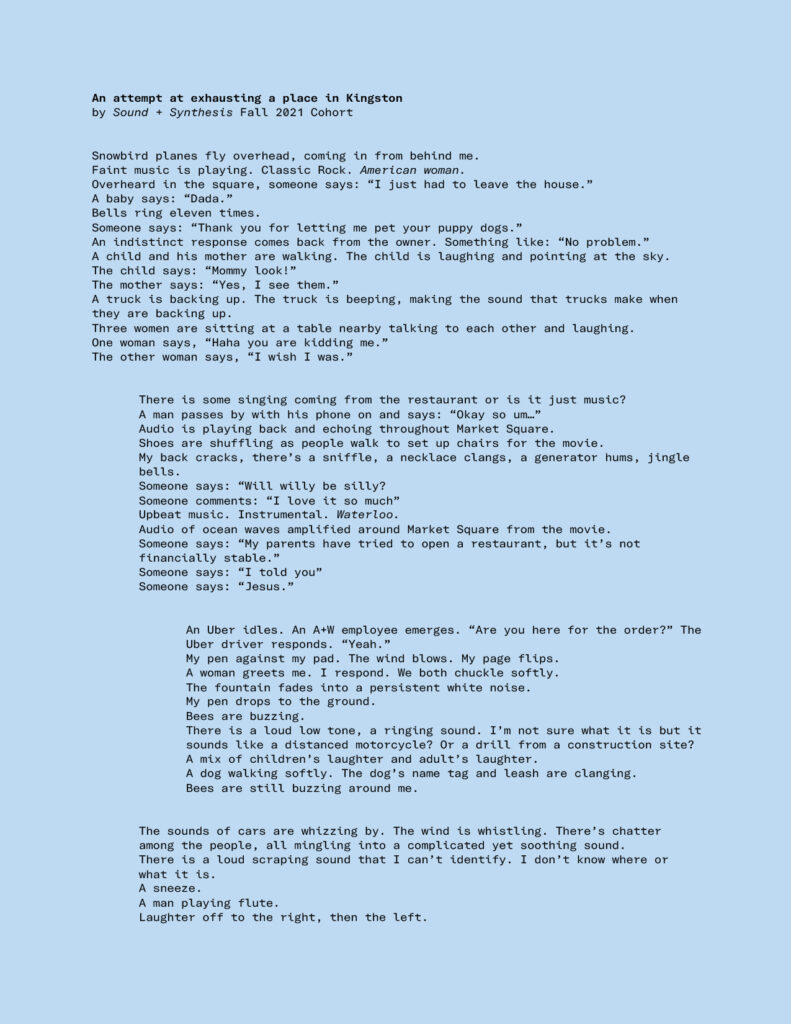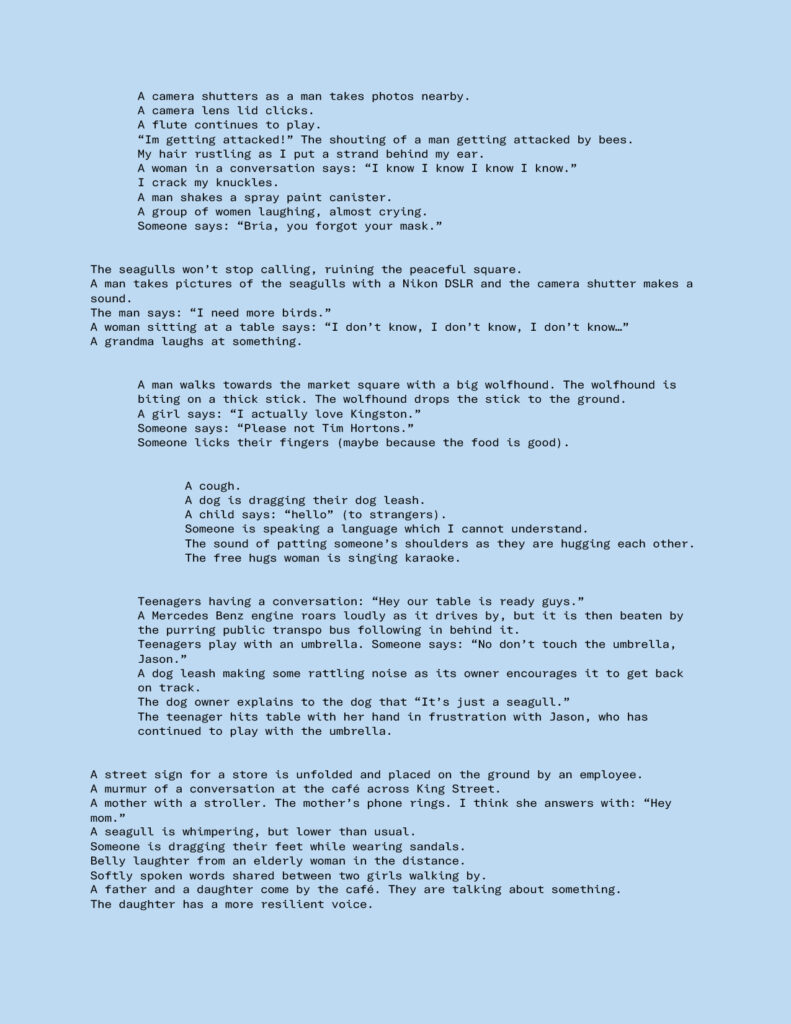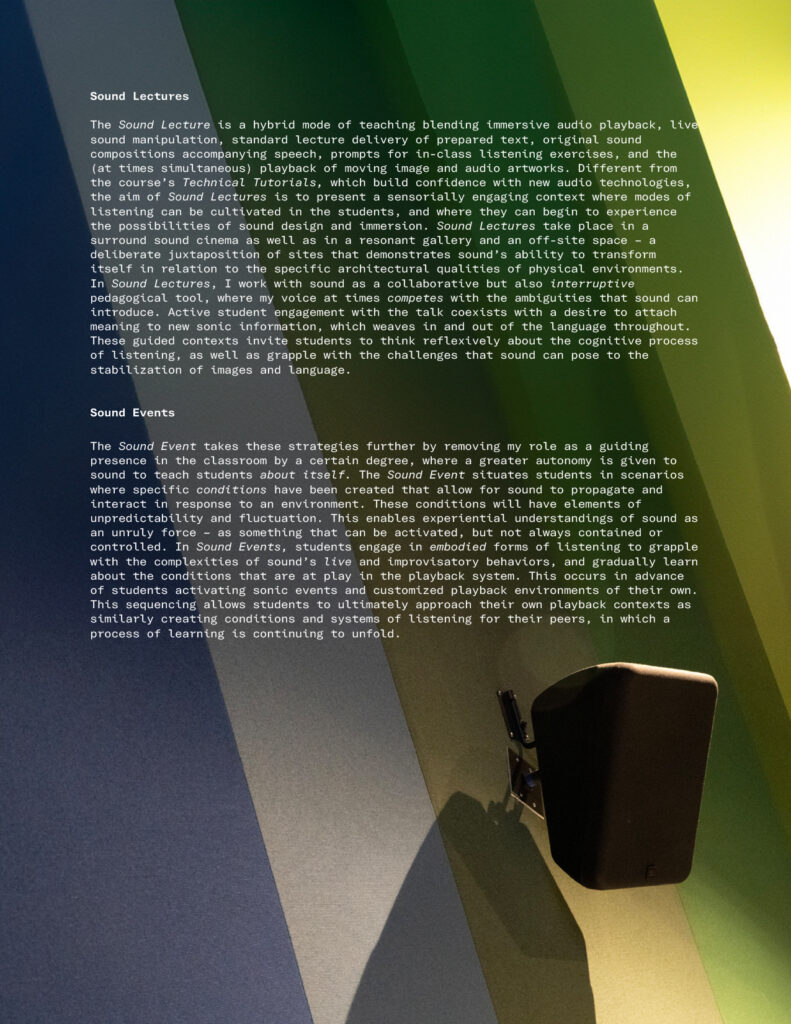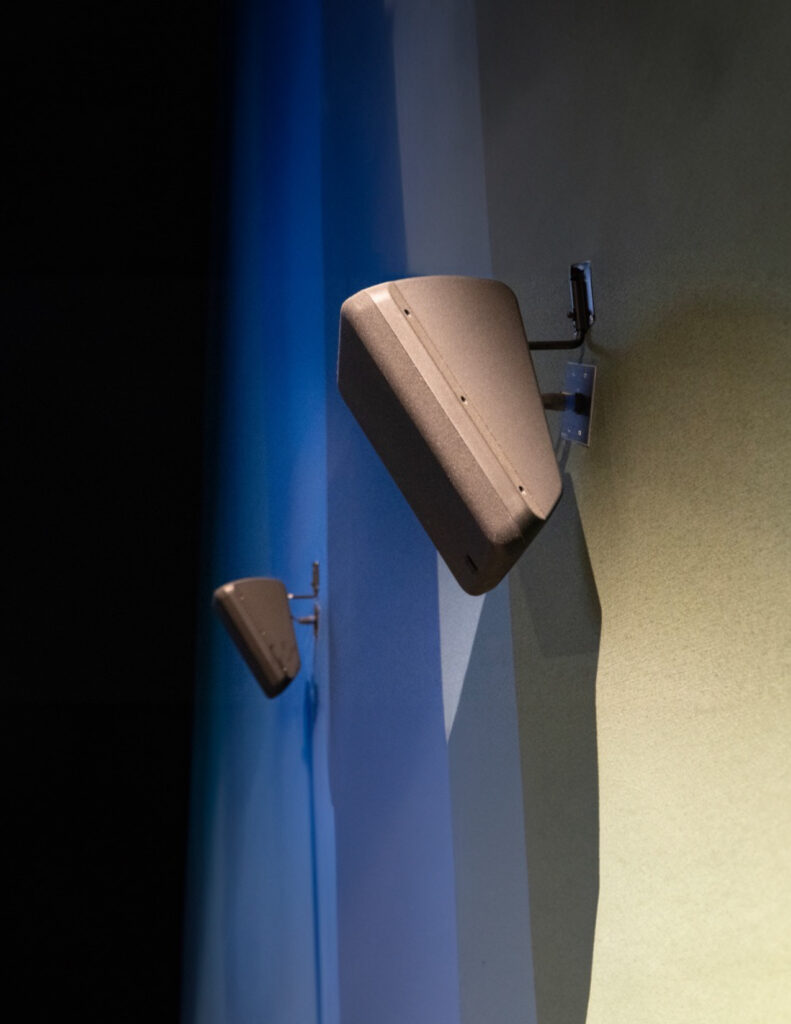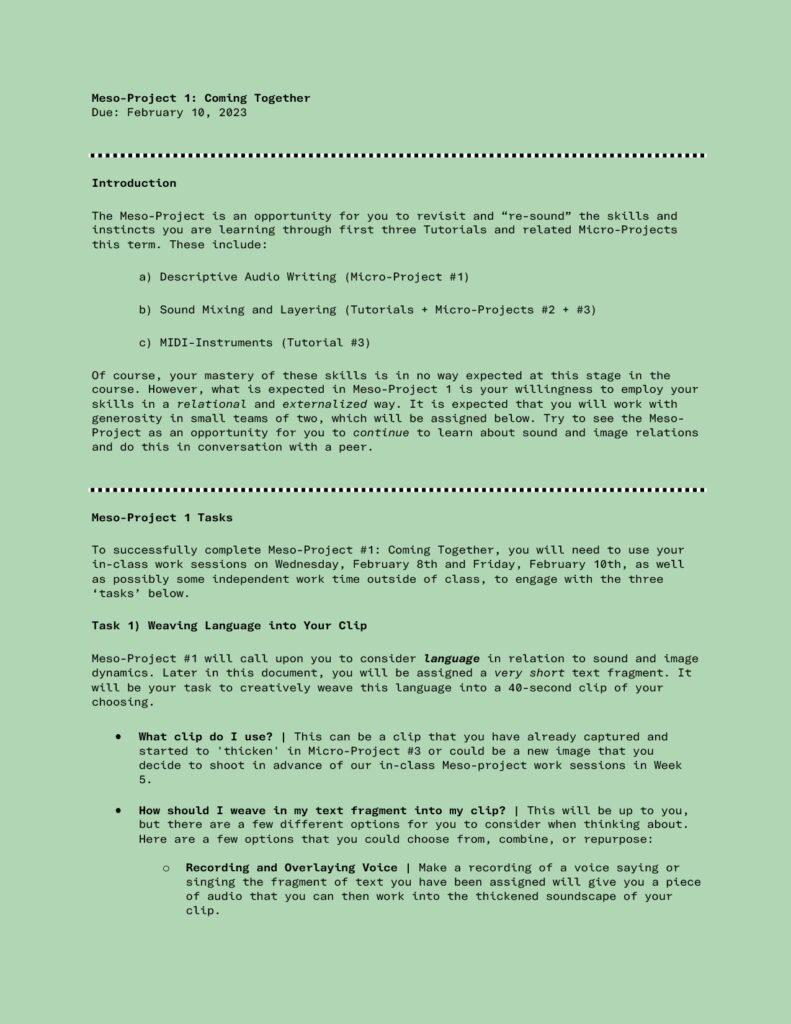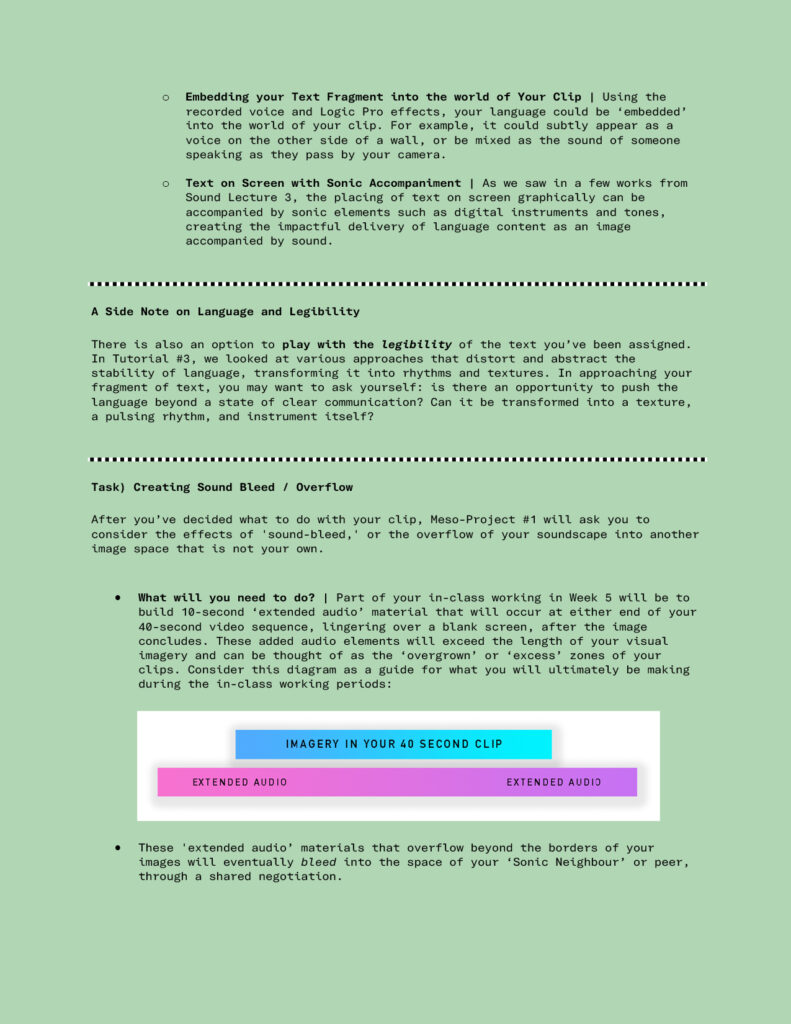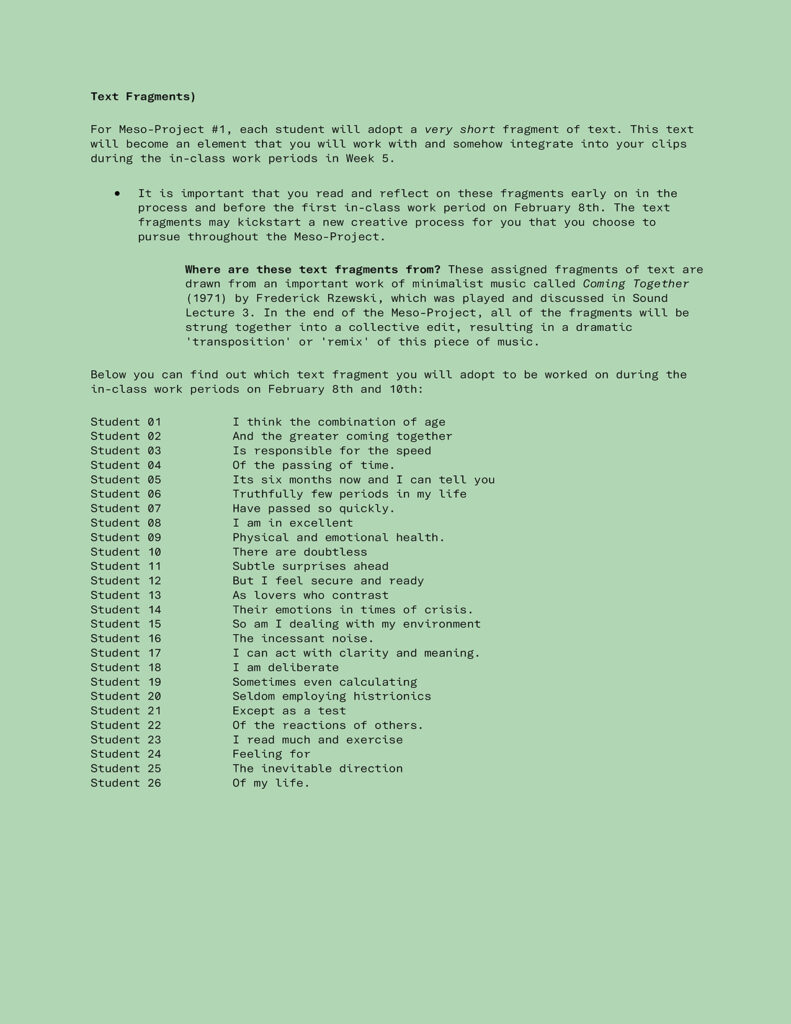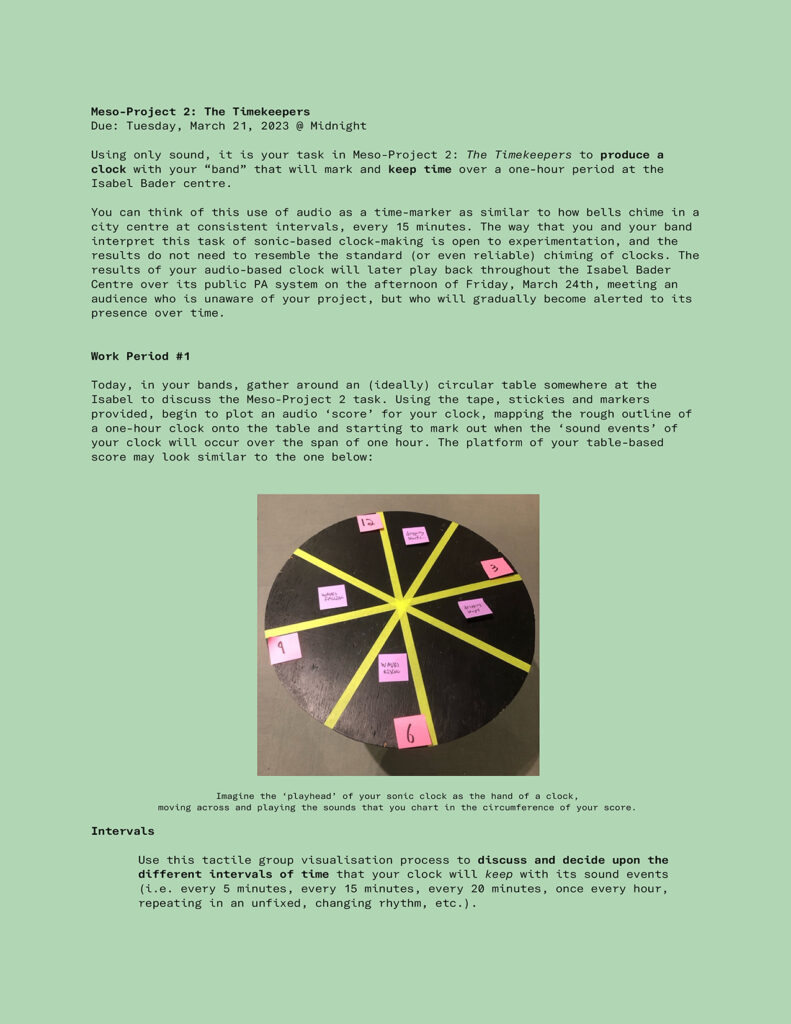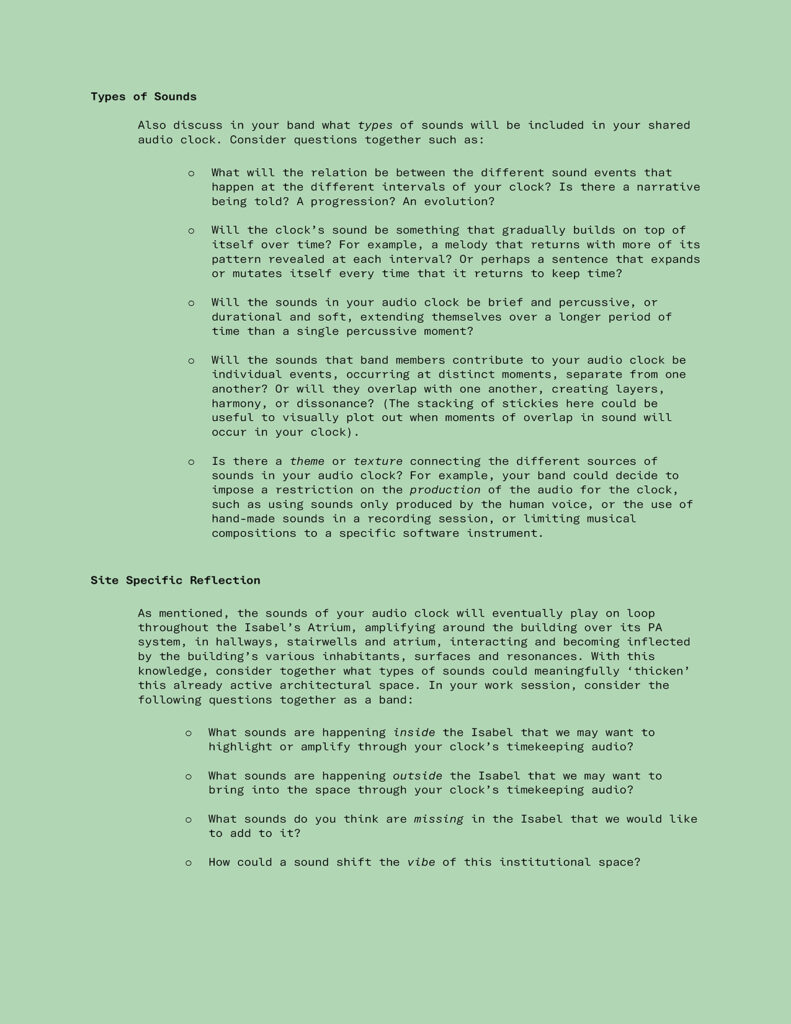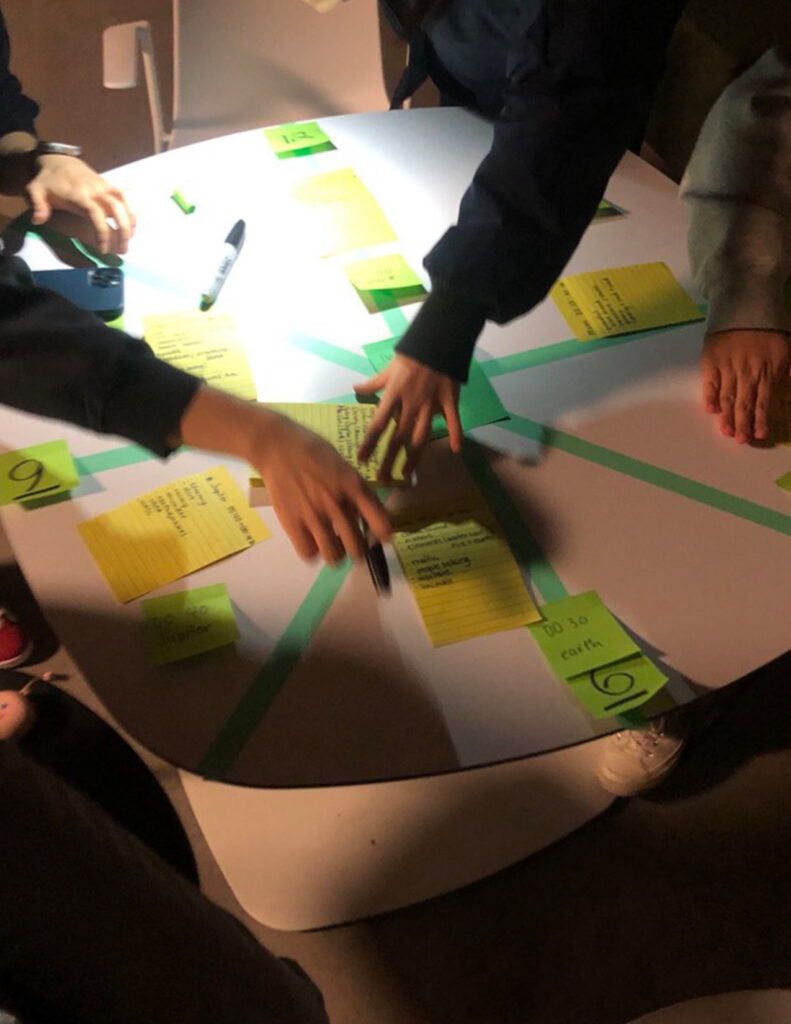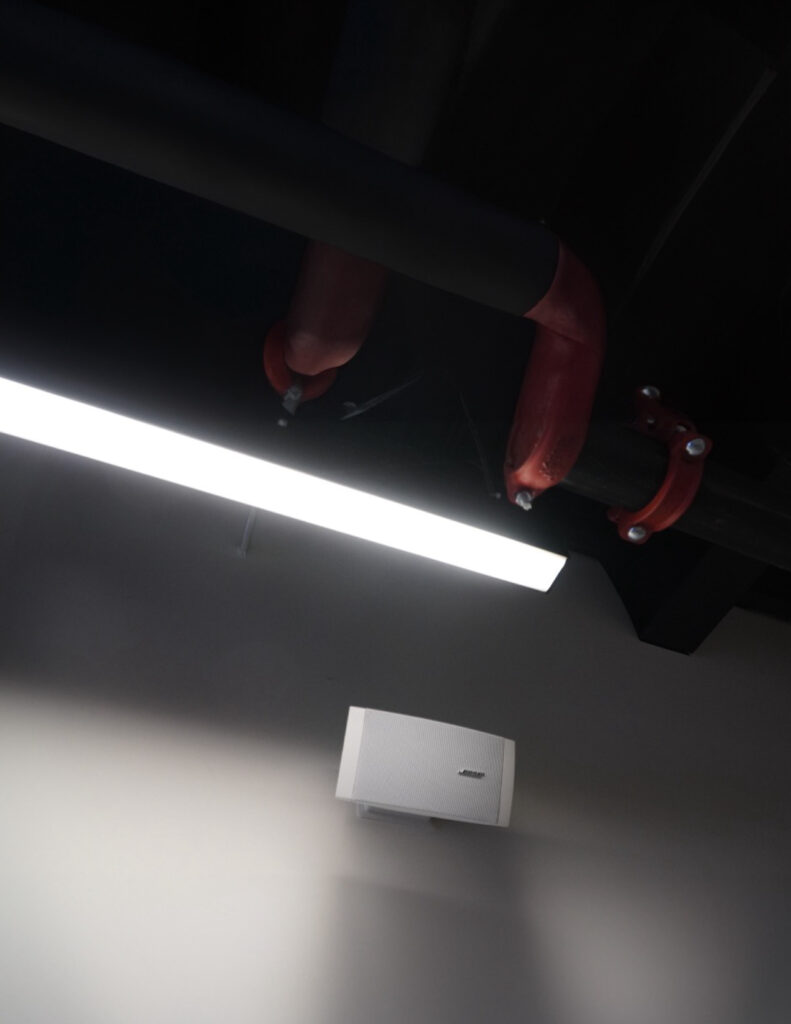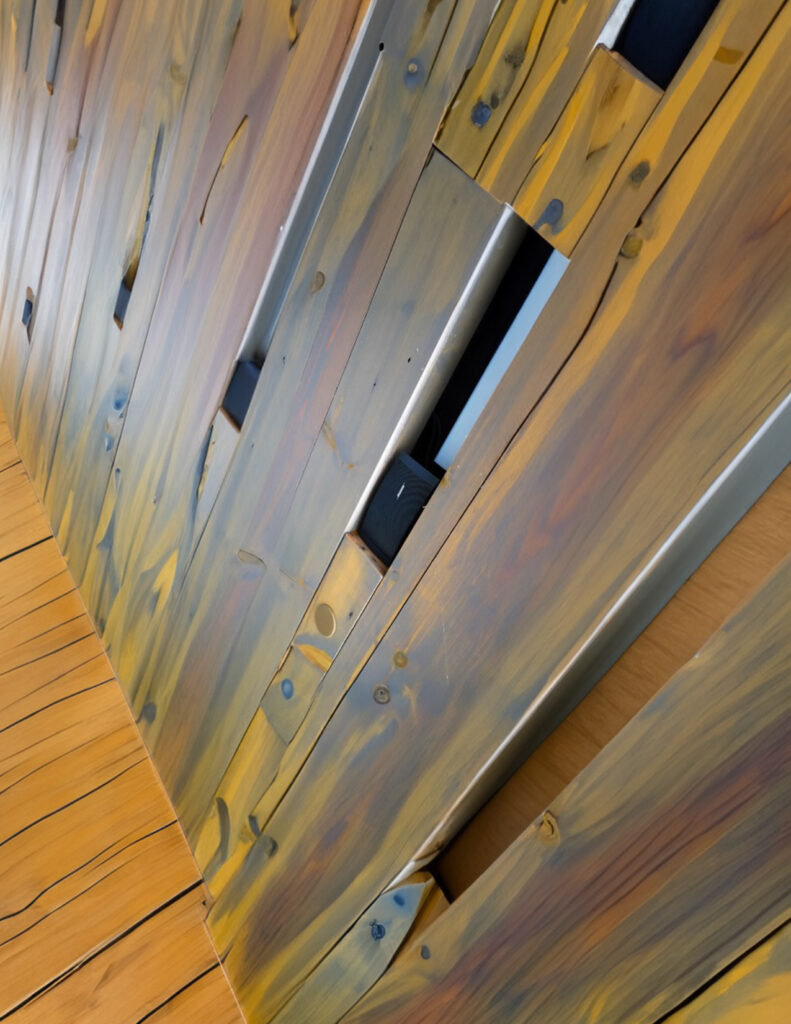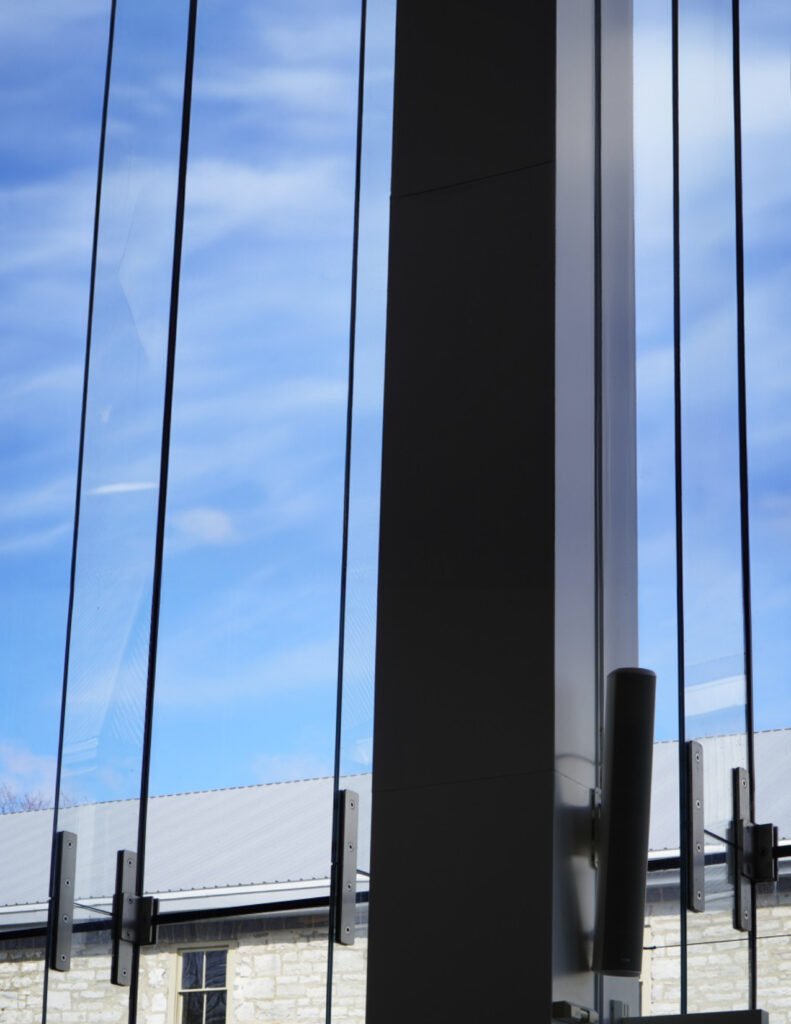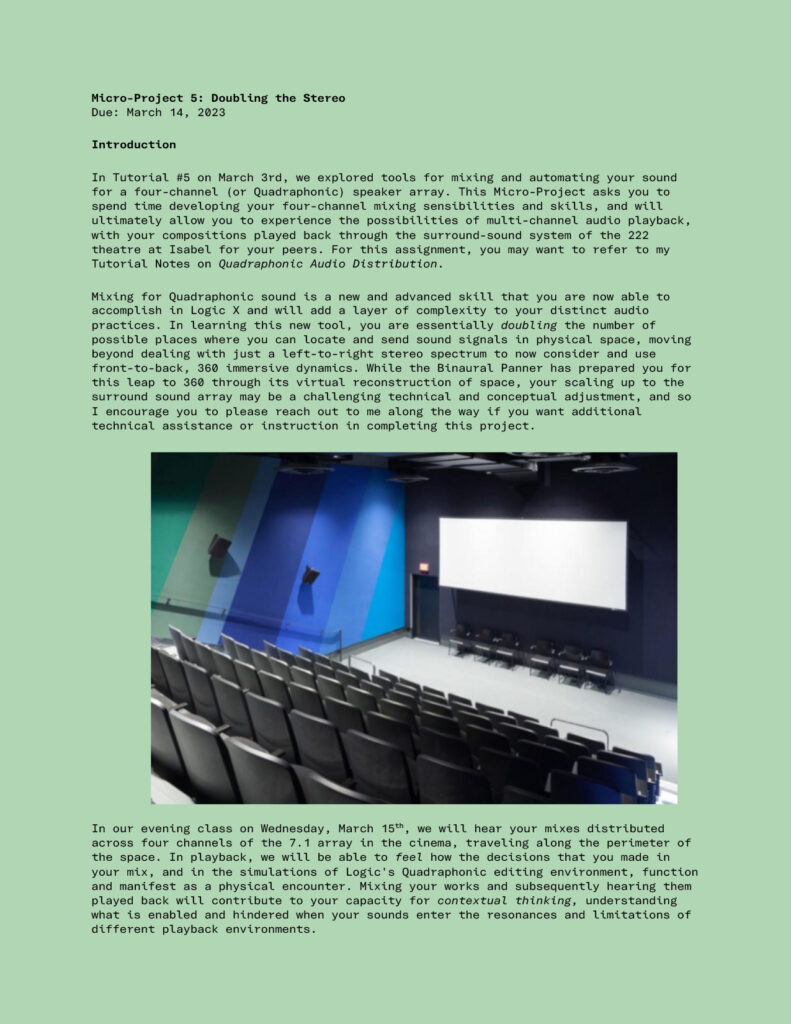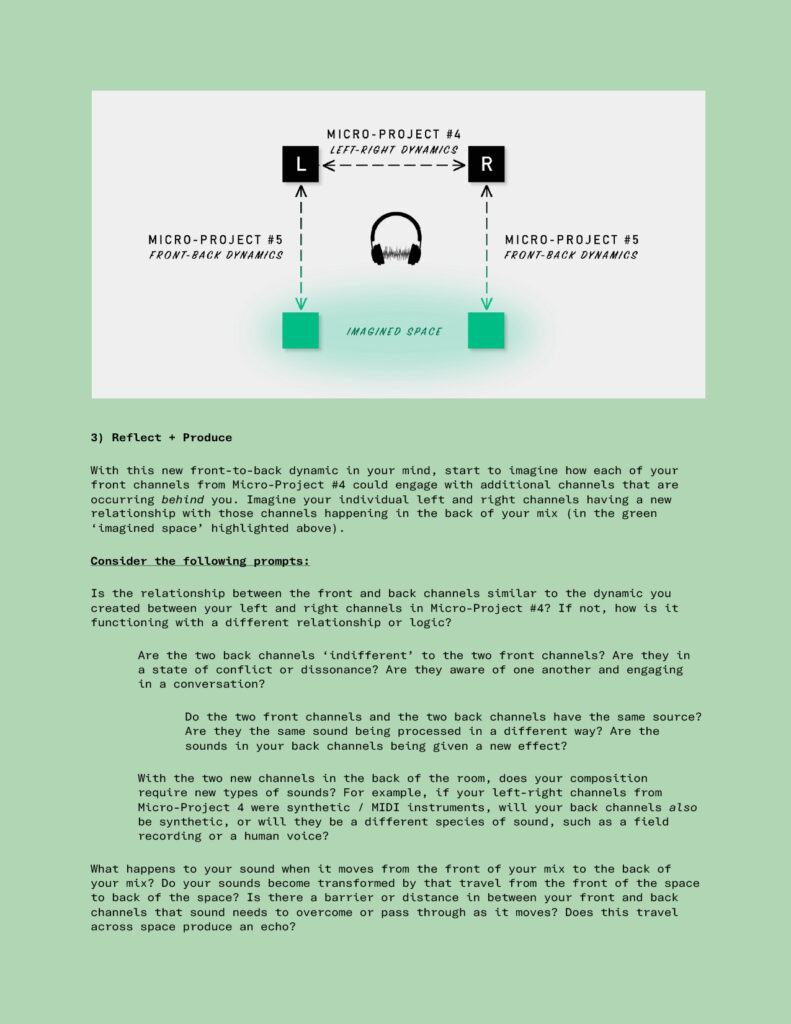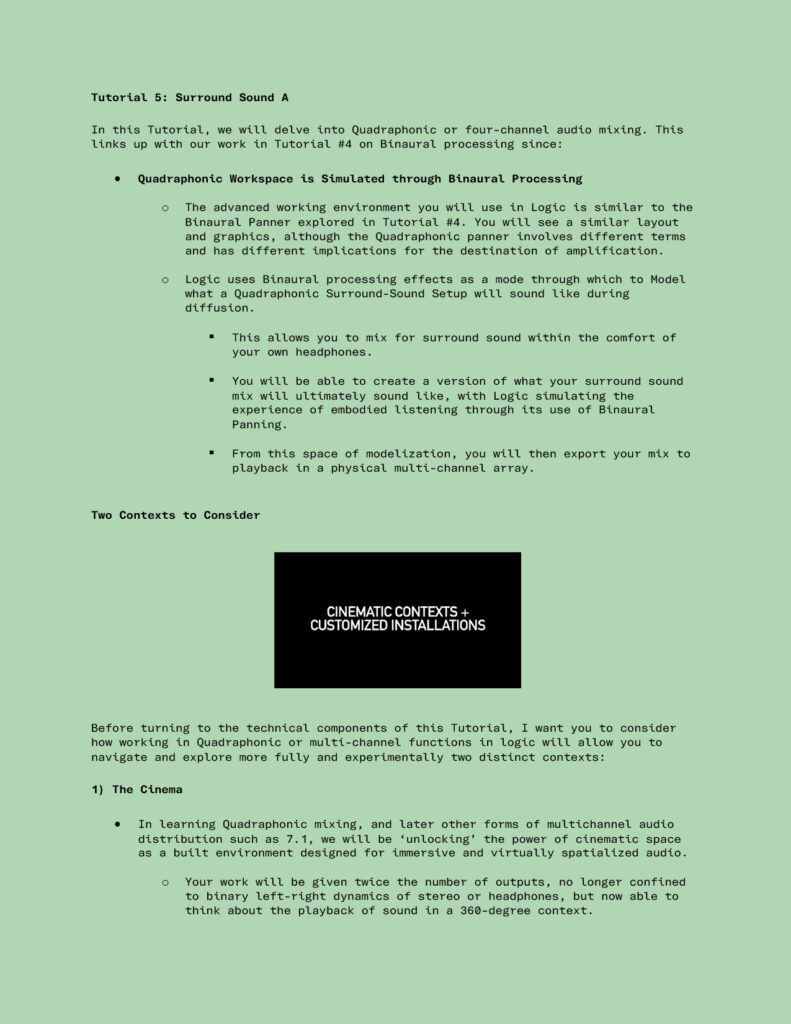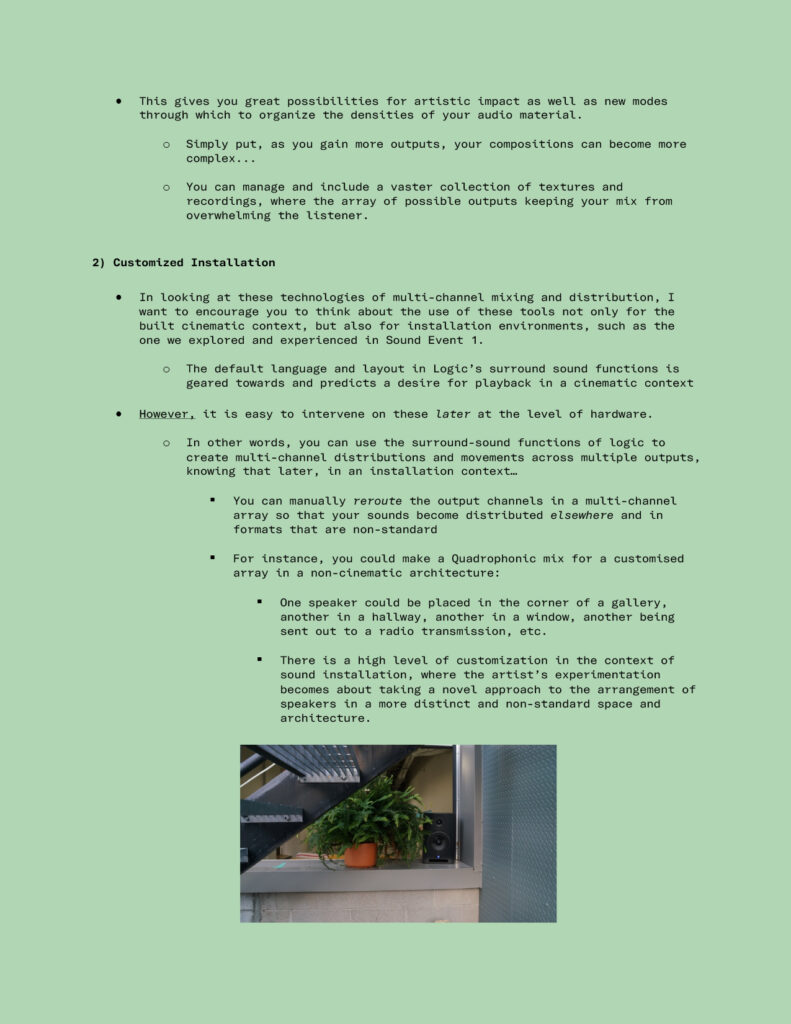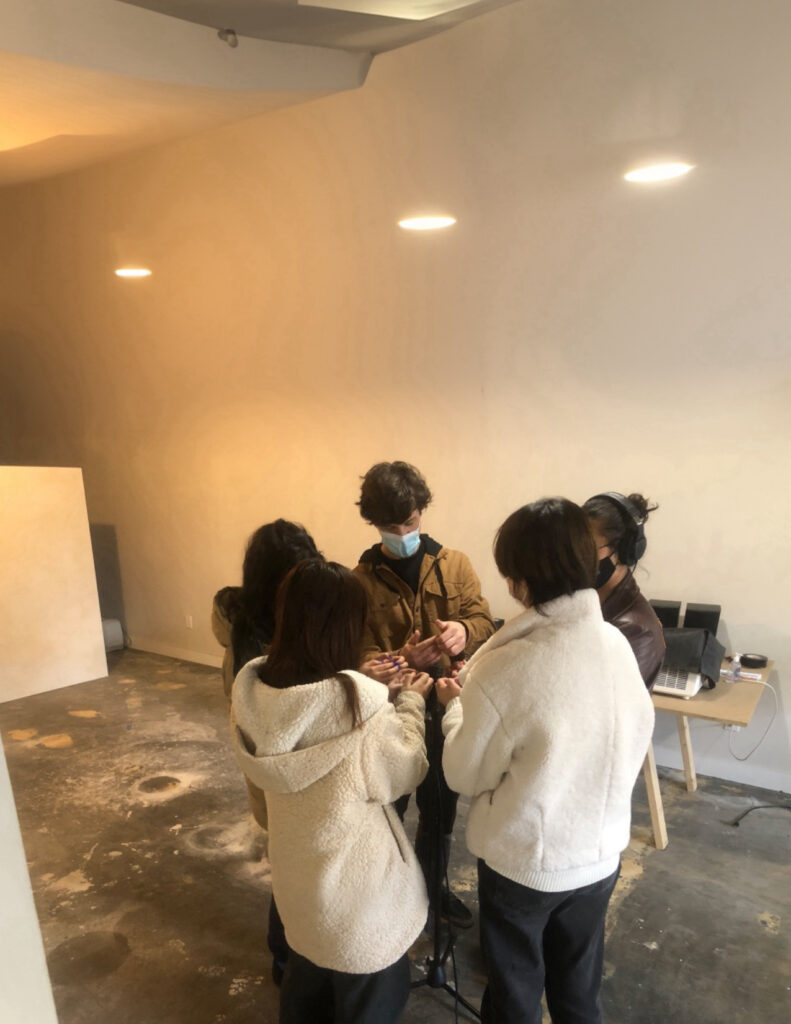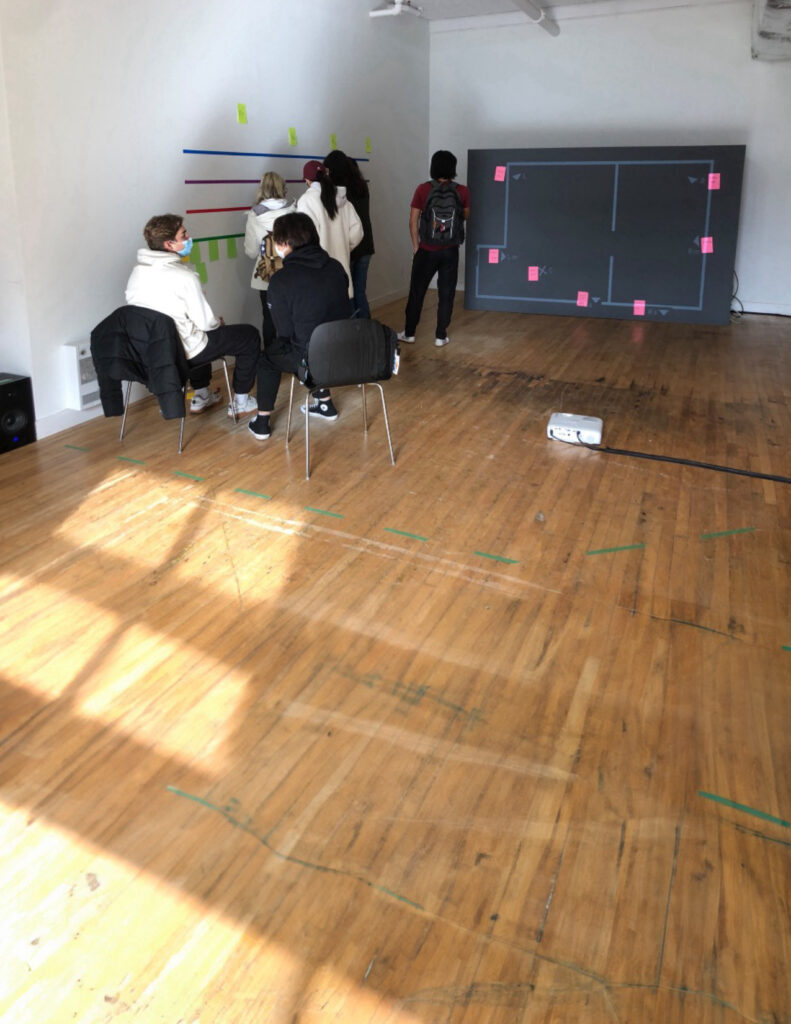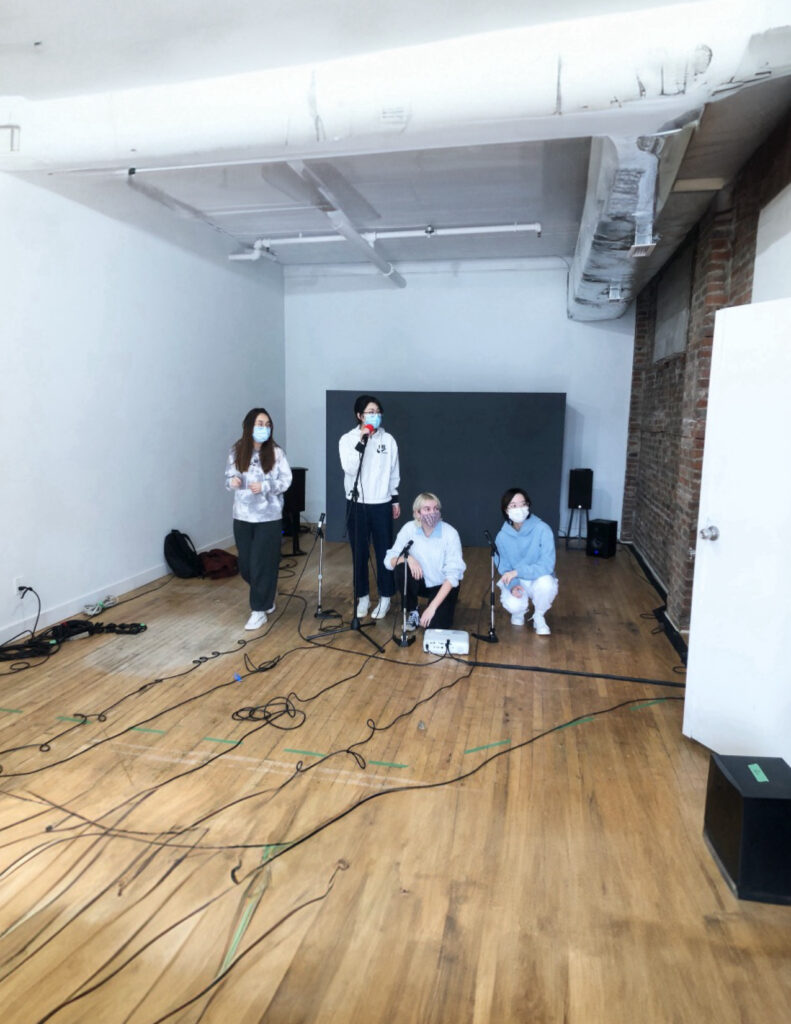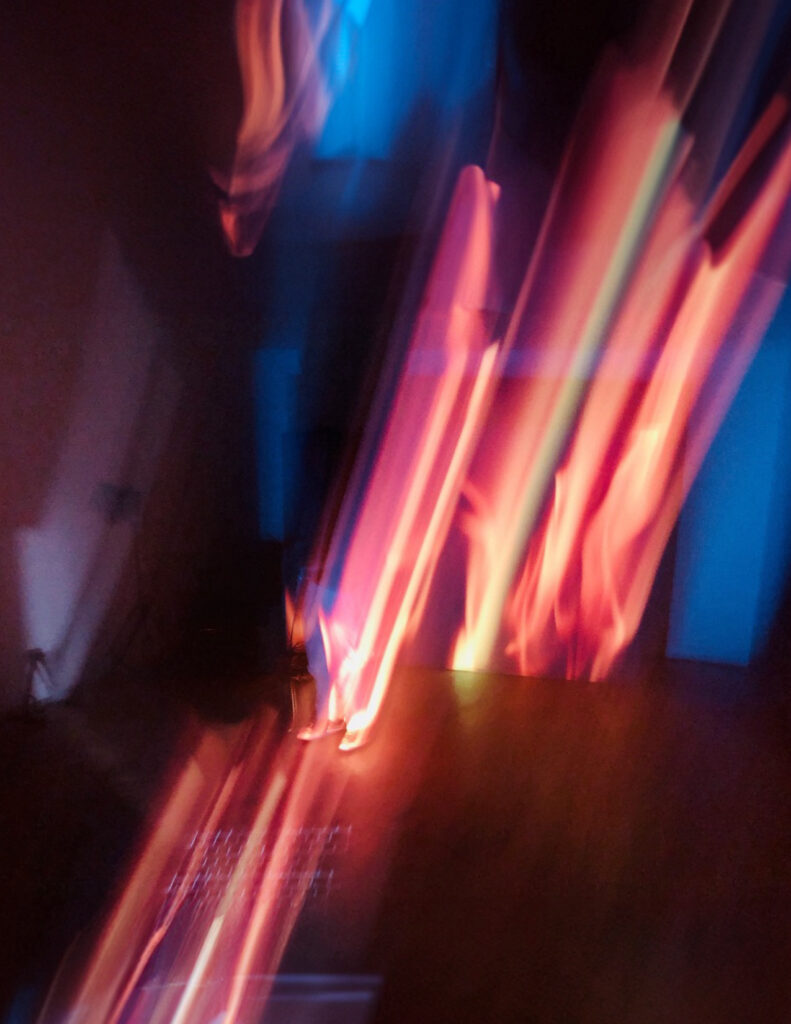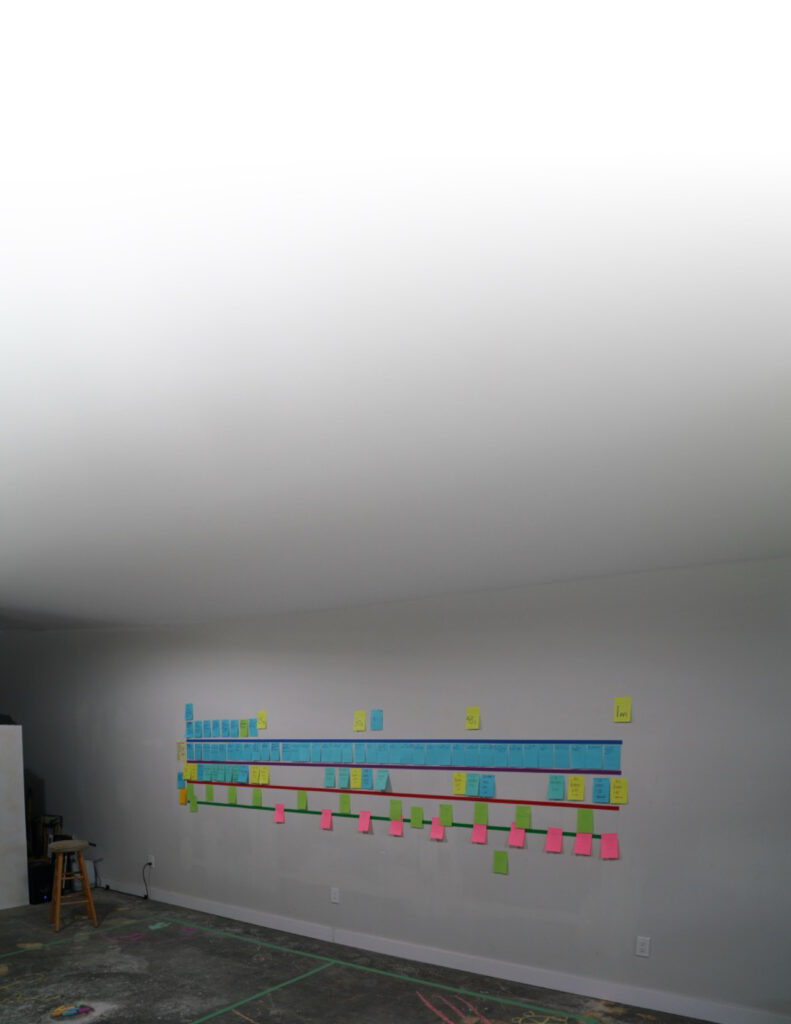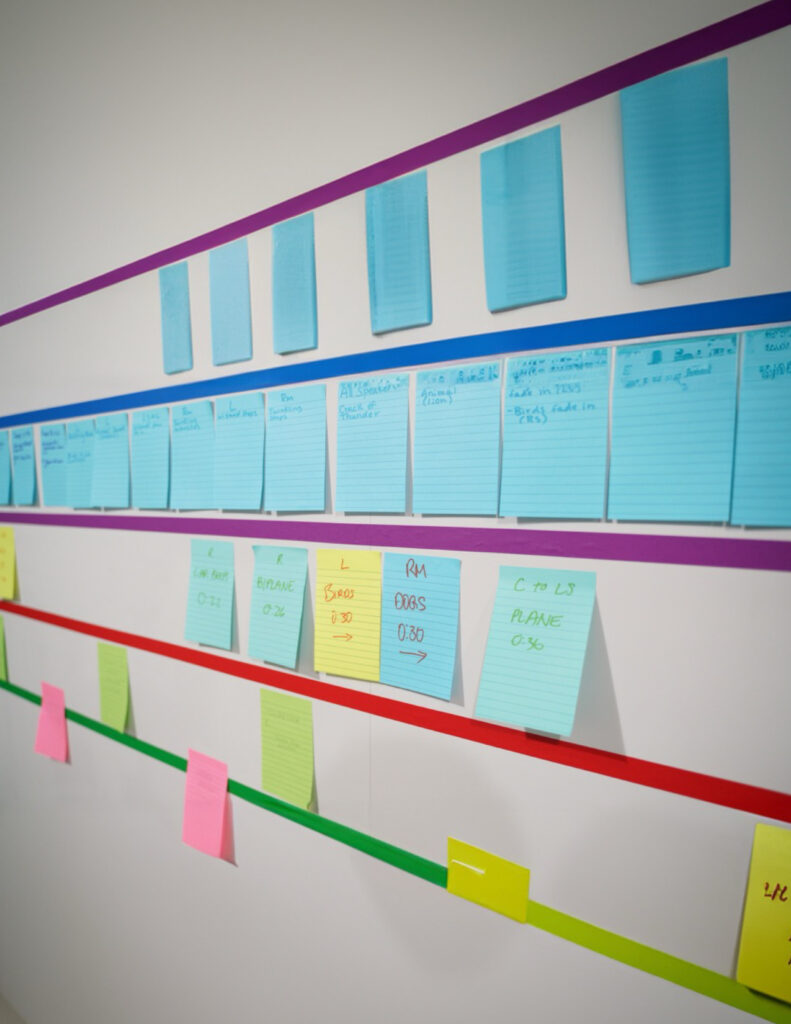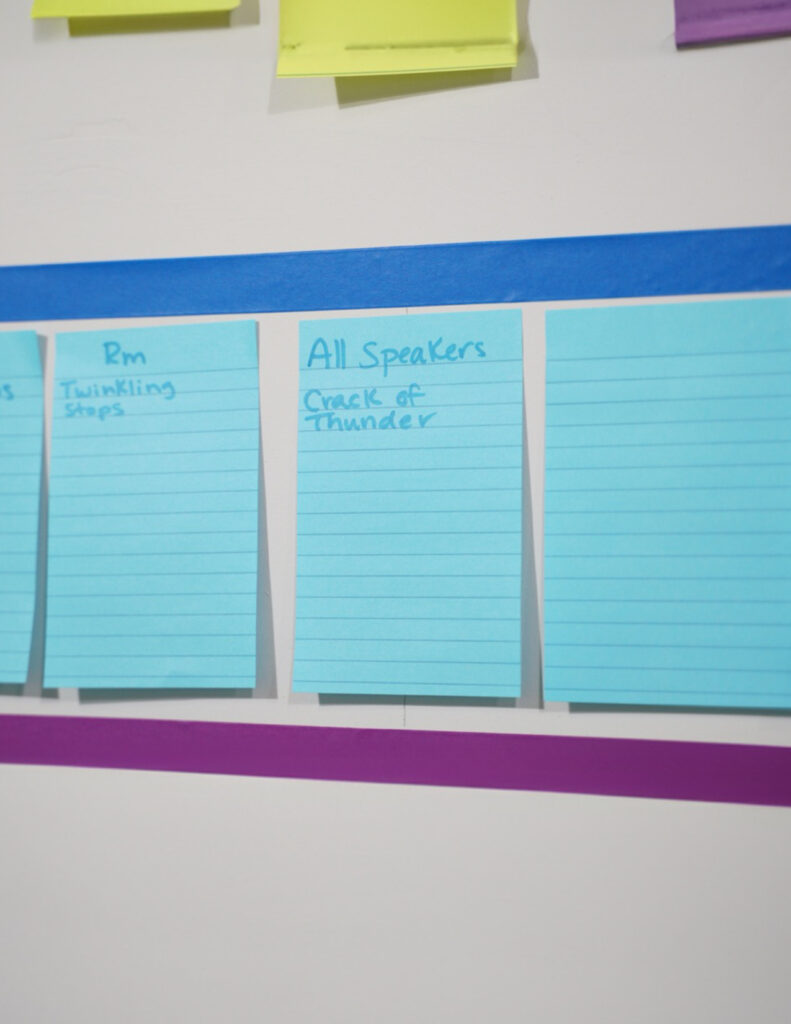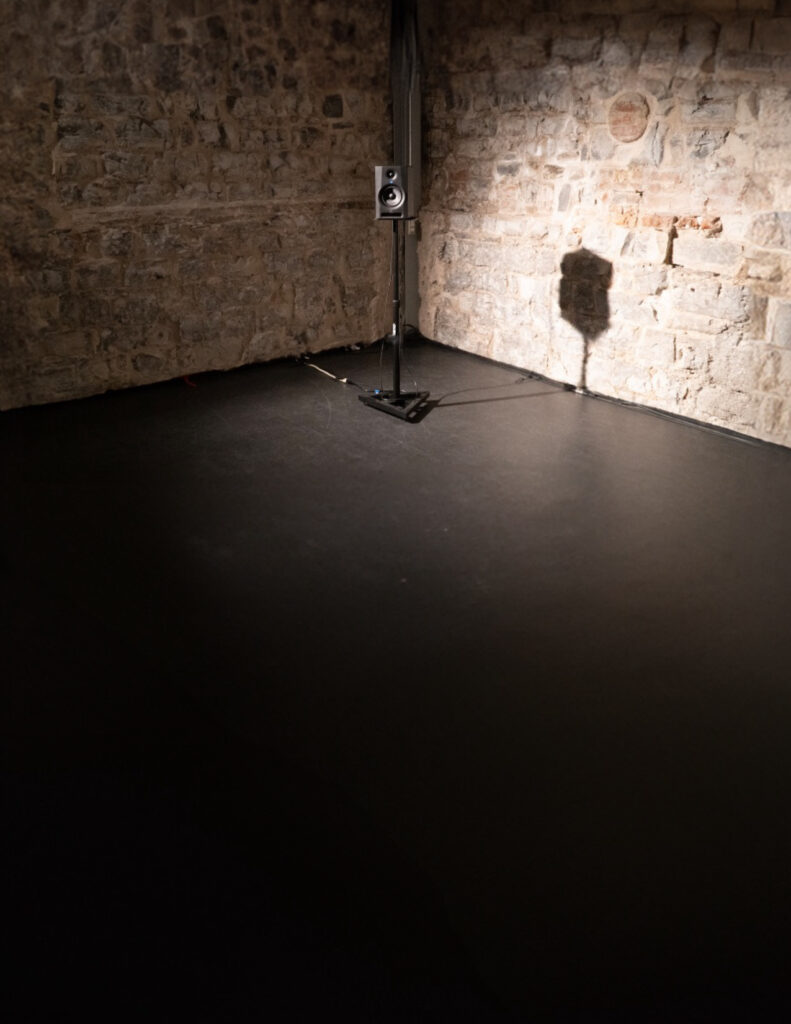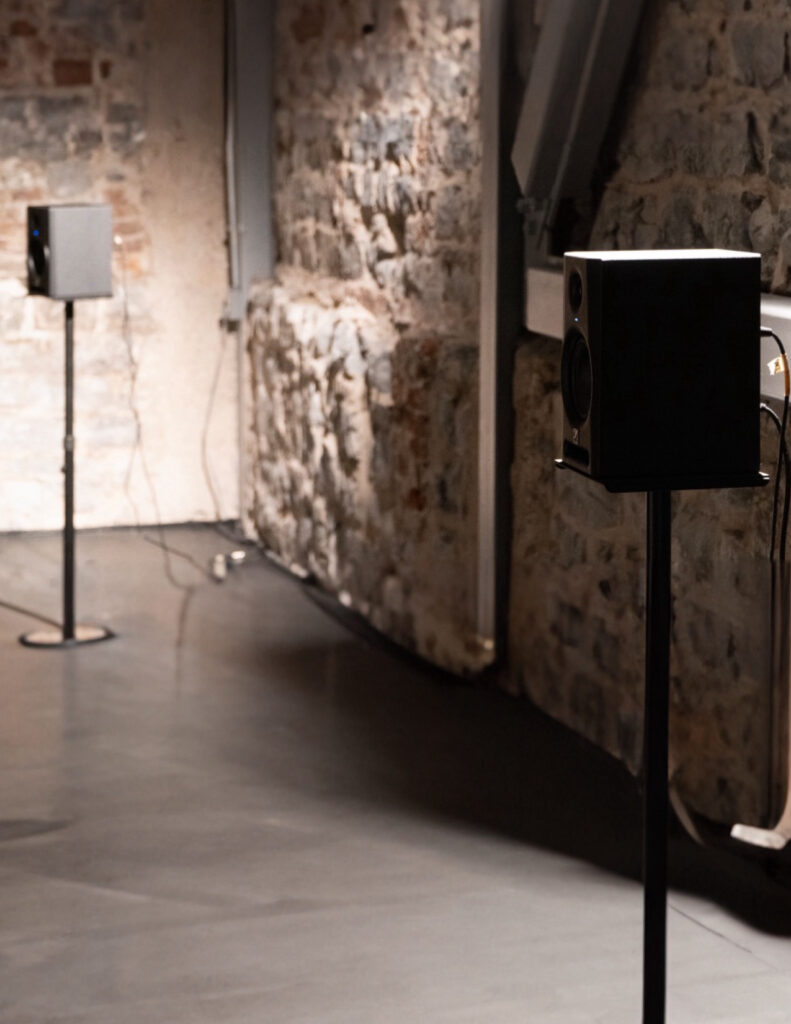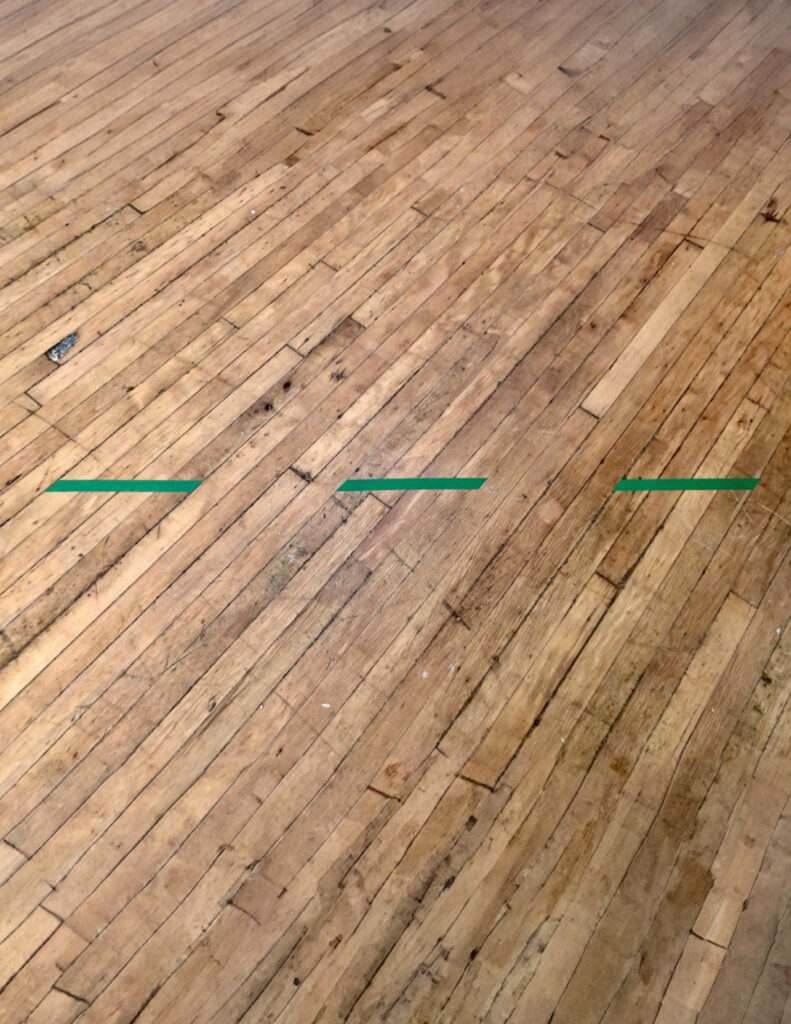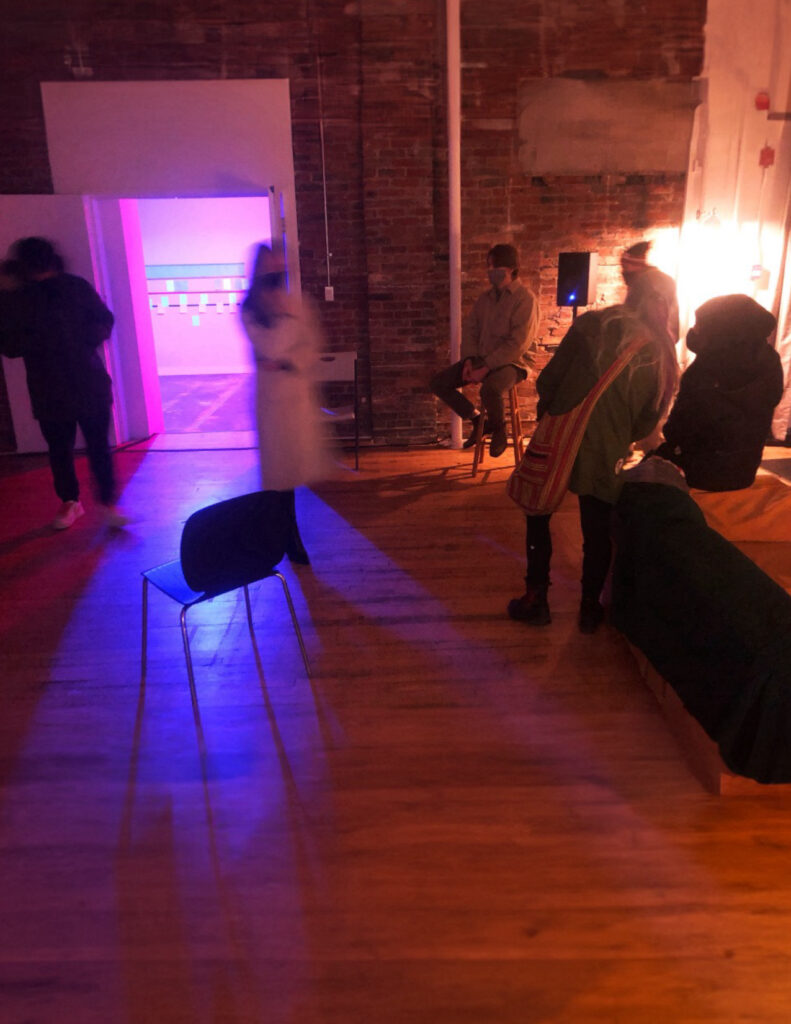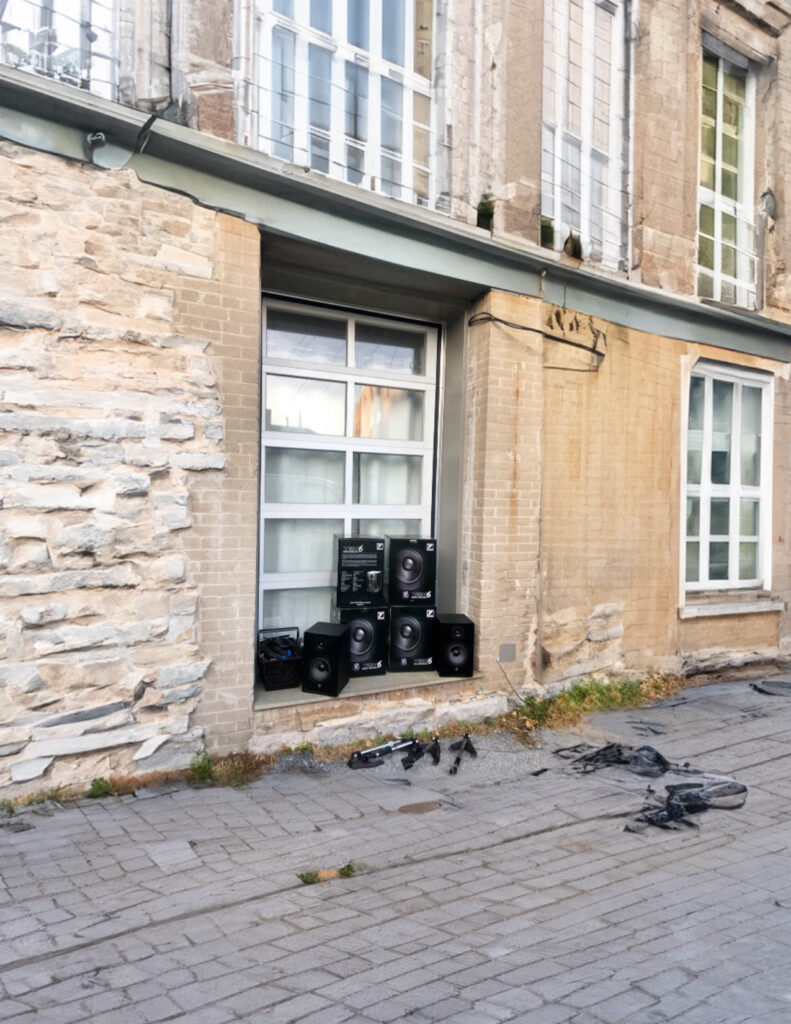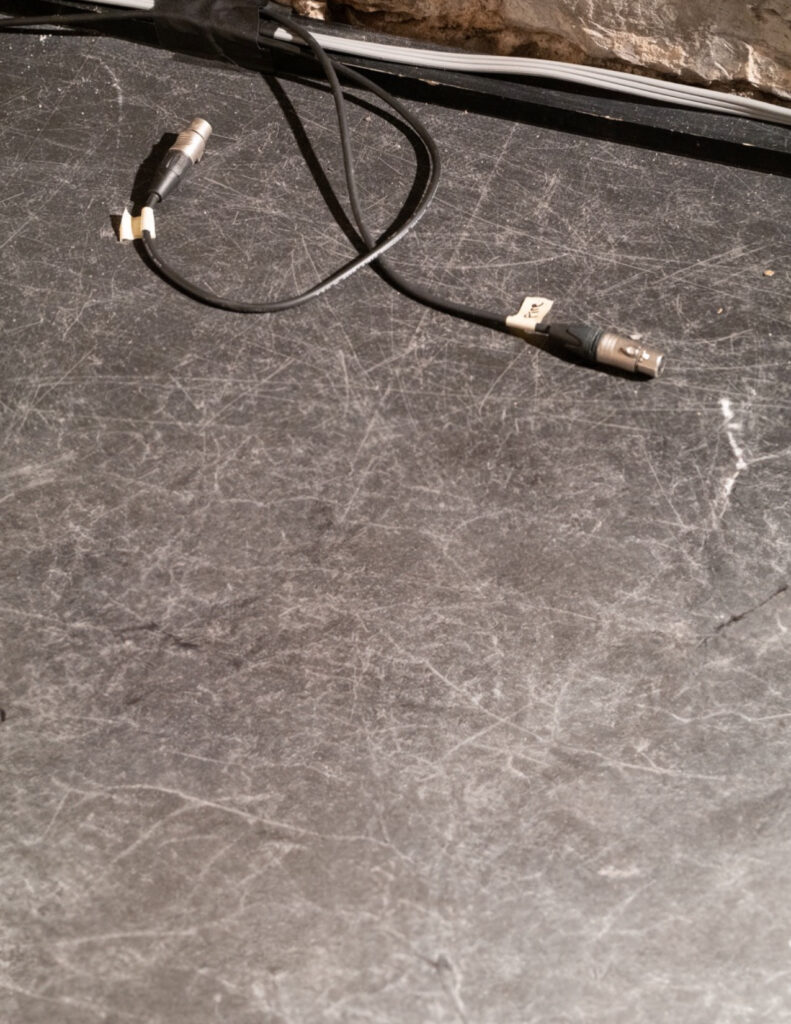Sound + Synthesis
Undergraduate Course
Queen’s University
Fall 2021 + Winter 2023
Winner of Dean’s Teaching Fellow Award in 2023
About the Course
Sound + Synthesis is an advanced artistic production course with a focus on sound, designed for students with an existing filmmaking practice. The course is built around a series of nonstandard learning contexts, in depth technical tutorials, experiential collaborative exercises, and concise project prompts for artistic production. Students specifically explore and discover new forms of sound-and-image relations through participating in an open culture of individual experimental making, group thinking, and reflexive listening. While the course involves a great deal of technical instruction about audio recording, digital editing, and sound design, it simultaneously builds set of conceptual and theoretical tools that allow for emerging filmmakers and artists to think more deeply about sound’s importance in image-based artworks, as well as explores its possible applications beyond supporting or serving visual content. In this way, the course has an embedded critique in its aims and structure, as it works to invert dominant ‘ocular-centric’ approaches to film reception and production, which maintains a sensory hierarchy that prioritizes the imagistic over the sonic. Students leave Sound + Synthesis with a greater understanding of the complexities of sound as both makers and receivers of film, a new ability to attune themselves to the embodied experiences of listening, and a sensitive understanding of sound’s relation to physical environments and the world around them.
Course Structure: Micro, Meso, Macro
The course is structured around a series of customized learning environments and a consistent rhythm of production prompts. These allow students to develop conceptual, technical, and cognitive tools, while building their artistic sensitivity towards sound. Over time, an inversion occurs of inherited sensory hierarchies as new modes of listening and attention are cultivated in students. This works as a cognitive gateway for students to attune themselves to the rich world of sound that is embedded in their own film practice – one that is revealed to be hiding in plain sight, in the shadow of socialized sensory biases. Student comments have documented this shift, where they describe their experience in the course as having allowed them to “discover the beauty of sound” and finding “immense joy,” “passion and curiosity” by “witnessing how sounds connect.”
The course works towards these discoveries by a maintaining a production and creativity-driven learning environment. The structure navigates three scales of production assignments that call for artistic thinking and reflexive making – Micro-Projects, Meso-Projects, and a Macro-Projects.
Micro-Projects are core and inter-linked building blocks in the learning culture of Sound + Synthesis. Considering sonic phenomena itself as a guiding principle in the course’s structure, I established a relation between five Micro-Projects that allowed students to ‘amplify’ or ‘re-sound’ their own work. For example, a production response in one Micro-Project becomes the foundation of the following Micro-Project, which might ask the student to ‘thicken’ their past assignment with new sounds or make an alternate version of it for a surround-sound environment. This emphasis on the ‘re-amplification’ of projects allows students to experience the irreducibility of sound, and its capacious quality as a material for artistic exploration. Students begin to approach Micro-Projects as experiments that are never closed, but instead constantly open to sound’s capacity for layering and the recontextualization of experience.
Meso-Projects call for students to externalize and share their emergent knowledges with peers. Two Meso-Project assignment prompts require students to be both a learner and a teacher, and pool together their technical capacities to accomplish a shared task. The project structure is again driven by a consideration of sonic phenomena, in this case sound’s uncontainable nature as a vibration. The concept of ‘sound bleed,’ where sound can move through architectural barriers, mobilizes collaborative Meso-Project contexts. Students are asked to negotiate the ‘overflow’ of their own sounds into the perceptual territory of their peers, and vice versa. This process allows students to experience the diffusive nature of sound, understanding its behaviour as different from the contained stability of the image and its bordered frame. Meso-Projects harness sound’s desire to propagate itself beyond boundaries, using this as a language for peer-to-peer working and necessitating the creation of collaborative practice.
The single and concluding Macro-Project in the course structure prioritizes the inverse importance of individuation. Throughout the course, students respond creatively to the Micro-Projects and Meso-Projects and discover a range of technical skills and artistic sensitivities. In a culture of creative exploration, each student gradually gravitates towards specific concepts or techniques that generate for them the most curiosity and joy. The Macro-Project is framed as an opportunity for students to revisit and ‘re-amplify’ an element in the course that most resonated with them. They design a project that allows them to strengthen and push their capacities in a chosen area, which are discussed in 1-on-1 meetings. This opportunity for the student to specialize their learning signals a customized final phase of the course, where students are grouped together around a chosen interest (for example, the technique of sound installation, or immersive surround-sound mixing) and form Affinity Groups. Each Affinity Group receives calibrated technical tutorials in a chosen topic, which function contexts for peer-to-peer learning to occur as the students face a common production challenge. Macro-Projects are fully driven by the curiosity of the students, as they continue the momentum of their artistic trajectories generated through Micro and Meso projects, and complete adventurous artworks through their desire to learn more deeply.
Experimental Pedagogy: Sound Lecture + Sound Event
Beyond this assignment structure, unique formats for pedagogical encounter approach sound as a collaborator in teaching. This strategy is explored in the form of the Sound Lecture and the Sound Event.
The Sound Lecture is a hybrid mode of teaching blending immersive audio playback, live sound manipulation, standard lecture delivery of prepared text, original sound compositions accompanying speech, prompts for in-class listening exercises, and the (at times simultaneous) playback of moving image and audio artworks. Different from the course’s Technical Tutorials, which build a student’s confidence with audio technologies, the aim of Sound Lectures is to present a sensorially engaging ad destabilizing context where new modes of listening must be cultivated in the students, and where they can begin to experience the possibilities of sound design and immersion. Sound Lectures take place in a surround sound cinema as well as in a resonant gallery space – a deliberate juxtaposition of sites that demonstrates sound’s ability to transform itself in relation to the specific architectural qualities of physical environments. In Sound Lectures, I work with sound as a collaborative but also interruptive pedagogical tool, where my voice at times competes with the ambiguities that sound can introduce. Active student engagement with the talk coexists with a desire to attach meaning to new sonic information, which weaves in and out of the language throughout. These guided contexts invite students to think reflexively about the cognitive process of listening, as well as grapple with the challenges that sound can pose to the stabilization of images and language.
The Sound Event takes these strategies further by removing my role as a guiding presence in the classroom, where a greater autonomy is given to sound to teach students about itself. The Sound Event situates students in scenarios where specific conditions of amplification have been created that allow for sound to propagate and interact in response to an environment. These conditions will have elements of unpredictability, indeterminacy, and fluctuation. This enables experiential understanding of sound as an unruly force – as something that can be activated, but not always contained or controlled. In Sound Events, students engage in embodied forms of listening to grapple with the complexities of sound’s live and improvisatory behaviors, and gradually learn about the conditions that are at play. This occurs in advance of students activating sonic events and customized installation environments of their own. This sequencing allows students to ultimately approach their own playback contexts as similarly creating conditions of listening for their peers, in which a process of learning about sound is continuing to unfold.
Student Comments about Sound + Synthesis
I have to say I really loved the way you structured our sound class. It was a format I had never really seen before with the varying class types and your actual interest in the syllabus material was really tangible and made everything a lot more interesting to learn about! Thanks again for your kindness and compassion this past term, profs like you make a real difference.
This project has allowed me to explore the intersection between sound and visual arts, and I am grateful to Professor Lochhead for providing me with the opportunity and guidance to finish this project. I was surprised to have my first exhibition in my life. I also want to thank every guest as they made it more dynamic. I hope this sound exhibition can take you on a journey and evoke emotions and memories, just like it did for me.
It was great to hear everyone else’s work at the final presentations. I was really inspired, and I already have a bunch ideas for a new project! I want to thank you again for the wonderful semester. This class was hands down the best course in all the courses I’ve taken. It was really fun, and I would have easily done at least an entire year of it.
It has been a great pleasure to be part of FILM 451 in my last year, discovering the beauty of sound as well as learning the skills of digital audio workstations. Although you are a new instructor, you treated each student like a friend and really stood with us to see the work. Whenever I read your feedback, I am filled with surprise and emotion. I felt that you took my practice very seriously and made a lot of constructive suggestions. Even if I don’t specialize in sound for the rest of my studies, I will continue to develop it and combine it with the videos or installations I create later.
I just wanted to say that I really really enjoyed your class, the environment you create, and the collaborative way you share what you know has been really inspiring.
The journey from being a novice in sound production to now having a deep passion and curiosity for it has been truly incredible. Working on my FILM 451 assignments has been a source of immense joy for me. The process of adding layers of sound to the music and blending diverse musical genres together has been particularly thrilling. I find it fascinating to witness how the sounds connect and overlap with each other, creating a cohesive and harmonious composition. It’s been an enjoyable and fulfilling experience that has ignited my love for exploring the world of sound production.
I’m glad I enrolled in this class from the waiting list this semester because I entered the film department late, so I had very little opportunity to take production classes. Looking back on the whole semester, I am surprised that I went from “no idea at all” at the beginning to be skilled in using sound production now. Three short months felt like they went by in a flash, but I learned skills beyond that time frame. I’ve recommended this course to almost everyone I know because it’s really fun, and I of course mentioned that the main reason is not only that but because you’re the best professor I’ve ever met!
